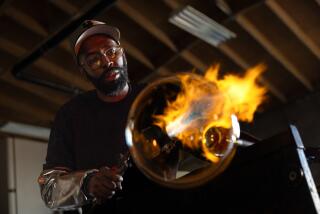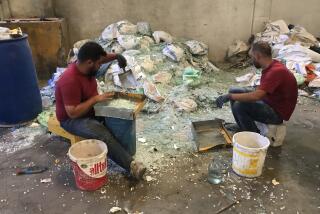TRENDS : It’s Not Always Crystal-Clear, but Glass Makes the Cut in Design
In simple accents and detailed crafting, in ways as diverse as light-refracting bevels and etched wildlife images, decorative glasswork is increasinglybeing used as a design element in the home.
There are scores of ways to glorify glass; it can be leaded, beveled, painted, enameled, antiqued, embossed. Many of these techniques remain unchanged since Medieval times, though the glass itself is appearing in new and modern designs.
“Really, what makes the difference in glass, lifting it from something purely utilitarian to an art form, is the skill which the craftsman brings to the glasswork project,” said Tom Henry, a glass craftsman of 24 years, who owns and operates Master’s Glass in Costa Mesa.
“You can have a piece of antique glass from Europe for $5 to $10 a square foot, or you can have a beveled, leaded, diamond-cut huge window or set of doors for $10,000. Both are lovely and give beauty to an environment; one just requires a lot more time and skill and craftsmanship. But anyone can enjoy glass in their home.”
Decorative glass can be introduced in ways as simple as replacing the standard glass in a curio cabinet with antique glass or hanging a piece of stained glass in a window.
Still, most people consider decorative glasswork a luxury, according to Tom Lloyd, owner of Bevelled Glass and Mirror in Newport Beach.
“I’ve been in the business since 1976, and you can see the curve go up and down with the economy,” he said. “But I also think people are seeing the art form in glasswork and are willing to pay what a craftsman needs to do the job right.”
The glasswork that Lloyd and Henry are talking about is meant to add lasting beauty to a home.
“It’s like a beautiful coat one will wear for decades--you’ll be willing to pay a (higher) price for it,” Henry said.
In doors, cabinets, windows and furnishings, the pieces are able to introduce detail that can transform the ordinary into the extraordinary. A decorative piece of glass in a door or an entryway, for instance, can help set a tone for an entire home.
Decorative glass can be purchased ready-made or custom-designed.
Ready-made beveled and leaded glass doors for the entryway in one Orange County home were purchased from a glass and mirror retail company for about $1,600 for the pair. The doors were crafted in Latin America, the glasswork beveled and leaded in Taiwan, and the pieces put together by a Compton company.
On the other hand, a pair of custom doors in leaded and beveled glass with complex etching at another home were worked on by a local glass artist for three months before they could be set in their teak frames. The cost was $20,000.
Choices in decorative glass range from utilitarian frosted glass to unorthodox free-form compositions.
There are three main elements in decorative glass:
* How the glass is made. Variations include hand blown or machine rolled, clear or colored, textured or plain.
* What is done to it. Decorative processes include etching, cameo cutting, engraving, painting and enameling.
* How it is put together. Assembly processes include connecting pieces with leading, copper foil or zinc.
Knowing some of the terminology of glass can help consumers considering adding glass detail to their homes to know what their options are.
Glass Types
Here are some basic kinds of glass:
Sheet glass. Generic plate glass from one-sixteenth of an inch to one inch thick. It is priced according to thickness, from $1.25 to $20 per square foot.
Antique glass. Hand-blown or machine re-creation and elaboration of the nuances in genuine antique glass. Bubbles, variations, striations and what some might term “defects” are deliberately included in the process. From $2.50 to $12 per square foot, depending on process. Opalescent glass. Color is mixed into the glass as it is created, then poured and rolled into sheets. This is the style of glass used in Tiffany lamps. From $2.50 to $10 or more per square foot.
Dalle-de-verre glass. Blocks or chips of glass cast in a resin to create an abstract form used in contemporary designs, particularly windows.
Fern glass. A special glue is applied either in a design or all over the surface of glass that has been sandblasted. The glue pulls the glass off in shapes of ferns, shells, etc. Double fern glass is a repetition of the process that gives the glass a double-chipped texture. Runs from $3 to $15 a square foot.
Rolled or textured glass. The glass is rolled in large sheets in various textures. Available in varied patterns, colors and degrees of transparency. Also referred to as Cathedral glass.
Flash glass. Generally hand blown. An antique glass with a thin layer of colored glass fused onto its base.
Stained glass. Paint and silver stain are used to define an image on pieces of colored or clear glass that is then leaded together.
“If a person wants a true Old World look, stained glass is one of the older processes,” Henry said. “The old church work was stained glass--pictures painted onto the glass in order to tell a story to those who could not read.”
Frosted glass. Acid or sandblasting has been used to opaque the surface.
Assembly Processes
Here are some key ways that pieces of glass are connected:
Leading. Pre-measured and cut glass pieces that look much like pieces of a dress pattern or an intricate puzzle are bound together with lead. Waterproofing putty is always placed between the glass edges and the lead to help in preservation.
Copper foil. Strips of copper foil ranging in width from one-eighth of an inch to an inch depending on thickness of the glass are wrapped around the edges. The pieces are then placed together and the joint is soldered on top of the glass.
Bracing. Metal braces are needed to keep a window from sagging or bowing. This is especially important on large pieces or those that will be subject to movement, such as in a door. Some craftsmen prefer to incorporate the braces into the design, others prefer a straight-across bracing.
Decorative Processes
There are many ways to cut or etch glasswork. Here are some:
Beveling. The glass is cut or shaped on the edges on a slant or incline. Beveled glass is what is often used in leaded glasswork, and can be quite thick. The beveling technique provides the refraction of light that is so intense.
“Beveled glass is beautiful, and lends itself to many different styles and periods of decor,” Henry said. “It became particularly popular around the turn of the century. Combined with other processes--such as sandblasting or diamond-cut work, it has added beauty.”
Acid etching. The glass is obscured by a solution containing hydrofluoric acid, which rapidly attacks the glass and dissolves its surface.
Diamond-point engraving. Done entirely by hand, using a small diamond bit set in a holder similar to a pen or pencil. Allows the user to sculpt the surface of the glass.
Sandblasting. A jet of abrasive material is projected onto the glass surface. The force of the impact of the abrasive chips a fine, granular texture into the natural or polished surface of the glass. In glasswork, the abrasive used is usually not sand, but rather a very fine grit of aluminum oxide.
Painted glass. Ceramic enamels, matte-type finishes and silver stain are used to “paint” glass. Enamel is a hard, glossy coating, in opaque white or colors. Staining uses an oxide or chloride of silver to create a yellow tone. Matte finishes are created by applying and removing parts of the paint to allow light to come through certain areas. Generally, glass painting is done at a light table, with the artwork or drawn design placed on the underside of the glass.
Brilliant cut work. Done using rotating wheels that deeply score the surface, creating polished prisms that increase light play. Cut glass is well known in work such as Waterford crystal.
French embossing. Acids or sandblasting combined with wheel work or brilliant cutting.
Copper wheel engraving. Done by holding the blank glass against a lathe-like machine fitted with grinding tools. Stuben glass is a good example of the delicate, intricate forms possible with copper wheel engraving.
More to Read
Sign up for Essential California
The most important California stories and recommendations in your inbox every morning.
You may occasionally receive promotional content from the Los Angeles Times.






